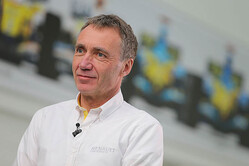 Over the course of his career, Bell has worked in a technical or managerial role that has helped secure nine Constructors' Championships and 10 Drivers' Championships.
Over the course of his career, Bell has worked in a technical or managerial role that has helped secure nine Constructors' Championships and 10 Drivers' Championships.
He graduated from Queens University Belfast with an Honours Degree in Aeronautical Engineering in 1979, completing a PhD in Aeronautical Engineering in 1982.
From 1982-1988 he worked with McLaren International, with positions including Head of Aerodynamics, Head of Research and Development and Project Director Unlimited Land Speed Record Attempt.
His first spell at Enstone was throughout 1998-1999 as Benetton Formula Senior Aerodynamicist, before moving to Jordan Grand Prix for 1999-2001 as Head of Vehicle Technology.
In 2001 he returned to Enstone as Deputy Technical Director then Technical Director (2003-2009), He stepped up to be Acting Team Principal (2009) and Managing Director (2010) before joining Mercedes-Benz Grand Prix Ltd as Technical Director from 2011 to 2014.
Bell joined Renault Sport Racing in 2016 as Chief Technical Officer, overseeing the outputs of both the Viry and Enstone sites to provide a strategic approach to their endeavours.
What is your outlook for the R.S.17?
I'm very confident. Our performance metrics show that we've made gains in a strong and consistent manner throughout its development. If you look at the car itself you will see tremendous attention to detail and sophistication, illustrating that it's been designed by a talented and knowledgeable group of people. This is a proper Renault Formula 1 car and what we know about it so far gives me a lot of optimism.
What has been the approach to the development of the R.S.17?
It's no secret that our 2016 car was not one born of a lengthy or smooth development process, so the R.S.17 is the first real Renault Formula 1 car of the modern era. It's a ground-up design as we had the time and the resources to do it, notwithstanding the fact that the change in the regulations demanded it. There is no carry-over in of componentry from 2016 to 2017, so it really has been a ‘clean sheet of paper' approach.
What detail can you give us about the R.S.17?
It's such a big regulation change that everything is new. We approached the design as a completely fresh concept so it's been a really interesting exercise.
It's 200mm wider, there's a lot more downforce and there are more possibilities to develop the bodywork with new bodywork envelopes to play with. Everything's new: suspension, bodywork, internal components, the lot.
Even the monocoque is different and that's primarily because of the packaging work we've done with Viry. We've been able to come up with efficient packaging around the power unit and the cooling systems and we've found what we think is a nice solution.
How big are the regulation changes for 2017, and what are the opportunities?
They are so fundamental that they represent a revolution in many regards. This is the chassis equivalent to the power unit regulation changes of 2014, and it's certainly more fundamental than the last big chassis change in 2009. The desire for the change was to make the cars a lot quicker and with a more modern appearance without compromising safety. The numbers we're looking at for lap time improvement does represent a sea-change in terms of performance.
The opportunities for us as a team are that the regulation changes mean going back to basics. Hence there are increased opportunities for us to take a step forward relative to our opposition, assuming, of course, we do a good job.
What has been the biggest challenge of the new regulations?
The aerodynamic concept has been the biggest change and the majority of our focus is on the bodywork. All teams will have added a decent amount of performance under the new 2017 rules, and it's not till we get to testing that we can see how good a job we've done in relative terms to our opposition.
The headcount of Renault Sport Racing has increased significantly, how quickly can the effects of this be seen?
In terms of our personnel growth and development, we're well along the path of getting to where we need to be. In terms of headcount, we're not far off our ultimate goal for 2017. Those already recruited are working well together as a team, and it's the cohesion of the group as whole that's important. This cohesion doesn't happen overnight, but the performance of our growing group of people has been impressive. Everyone at Enstone and Viry is united by a common goal and that is seen and felt every day.
There is, of course, a delay from a new starter walking into their department and the manifestation of their value being seen on track. The output from an experienced machine operator is seen more immediately than that of a graduate trainee designer. For some roles you won't feel the real benefit for six months, for others it's almost instantaneous.
Check out our Renault R.S. 17 gallery, here.






















sign in